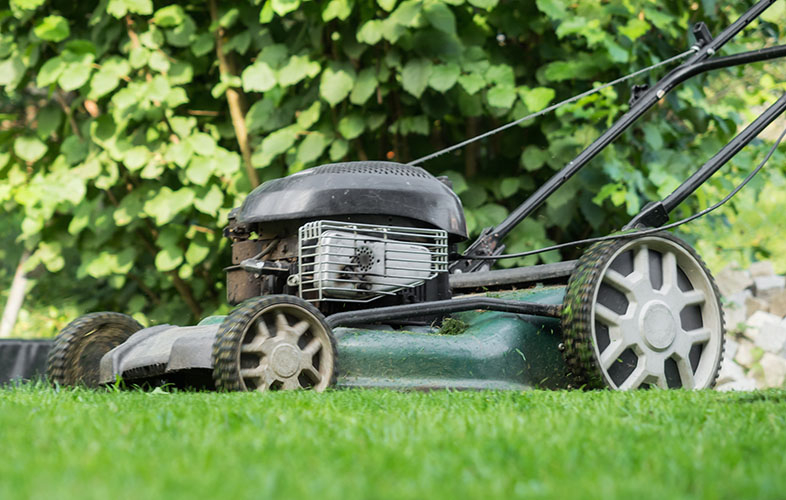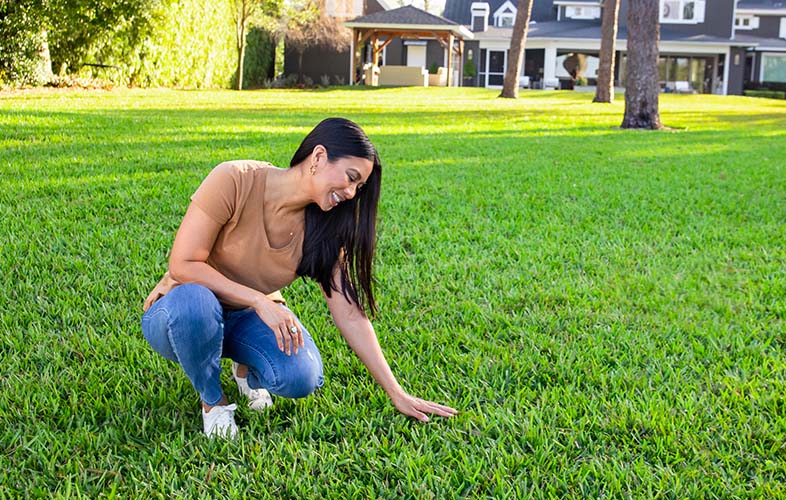Our ultimate Southeast lawn guide covers grass types, insect control, turf disease fungus. Read this guide to help you get a great lawn in the Southeast.

There are plenty of reasons a healthy lawn is an asset to your home. A lush lawn can cool the surrounding area and serve as a buffer from the noises of the city. It also helps boost air quality by trapping dust and other irritating particles. And perhaps best of all, a beautiful lawn will make your home the envy of the neighborhood!
If you live in North Carolina, South Carolina, Georgia, Alabama, Mississippi or Tennessee, sometimes keeping your lawn healthy and happy can be tough. Extreme temperatures, heavy foot traffic, soil and drainage problems, and adverse weather are just a few things that can impact your lawn's health. Don't forget about the insects and lawn diseases that can make matters even worse.
Lawn care can be tough, but you don't have to panic. With TruGreen, you'll find effective solutions to the problems that plague your lawn. Below you'll find an extensive guide to help you learn what to expect from your Southeastern lawn each season. We've included suggested treatment for common problems, so keep an eye out for issues that match your lawn's condition.
Types of Southeast grass
Do you know what grass is growing in your yard? Common grasses found in Southeastern lawns include Bahia, Bermuda, Centipede, St. Augustine, Tall fescue, and Zoysia; each comes with its own set of pros and cons.
Bahia
Pros
- Coarse-textured, tough turf
- Good tolerance to shade, drought, and wear
Cons
- Produces numerous seedheads
Bermuda
Pros
- Dense, medium-fine texture
- Excellent heat and drought tolerance
- Rapid establishment and growth rate
Cons
- Poor low temperature and shade tolerance
- Becomes dormant and browns during winter months
Centipede
Pros
- Low-growing, medium-textured turf
- Can handle light shade
- Drought-tolerant
Cons
- Slow growing (but this could be a pro if you don’t like mowing often!)
- Poor wear tolerance
- Browns in winter
- Requires high iron levels
St. Augustine
Pros
- Coarse-textured turf
- Shade-tolerant
Cons
- Poor low-temperature tolerance
- Can enter dormancy and discolor in winter months
- Produces heavy thatch
Tall Fescue
Pros
- Will grow in either partial shade or sun
- Tolerant of drought and blazing summers
Cons
- Not compatible with other turfgrasses
- Prone to thinning
Zoysia
Pros
- Dense, tough turf
- Good heat and drought tolerance
- Better cold tolerance than most warm-season grasses
Cons
- Slow to establish
- Becomes dormant and browns during winter months
Once you know your grass type, it becomes much easier to gauge the best watering technique and optimum mowing height for your lawn. Need help identifying the type of grass in your lawn? Our expert TruGreen specialists can provide you with helpful insights during a Healthy Lawn Analysis.
Unfortunately, even the healthiest lawn requires both preventative and reactionary efforts. Below, we explore potential weeds, lawn diseases and pests that can invade your lawn. Keep these in mind as you work with a TruGreen specialist to evaluate your lawn’s needs.
Types of weeds in the SoutheastNutsedge
There are two types of nutsedge: purple and yellow. Both are grass-like perennials that spread across your lawn using a complex underground system of tubers or "nuts" that allow new weeds to sprout. This hidden reserve of tubers make the weed quite difficult to manage.
You can spot this troublesome weed by looking for a triangular stem and three rows of leaves.
Clover
Clover is a notorious creeping, broadleaf weed that's tough to get rid of once its settled into your lawn. These perennials can take over large patches of turfgrass.
Clover is typically pretty easy to spot.The two most common types of clover, red and white, have flowers that stand out in turfgrass.
Black Medic
Black medic is an annual broadleaf weed that typically appears during the summer. Some of its most notable characteristics include globe-like clusters of yellow flowers and a small stem with three leaflets.
Dallisgrass
These coarse-textured grassy weed will spread across your lawn in circular clumps, growing out from the center and depriving your turfgrass of the air and nutrients necessary for survival.
Keep an eye out for its yellow-green color. You can also identify dallisgrass by its stems, which often have three to six spiky seedheads.
Spurge
The spurge family includes fast-growing summer weeds that grow low to the ground. Spurge is known as a prolific seed producer and plants mature in just a few days during hot weather.
Barnyardgrass
Flat and fan-shaped, barnyardgrass is an annual weed that has aggressive growth habits. It will steal the nutrients from your turfgrass and quickly dominate your lawn. Its bristly, purple seedhead is a dead giveaway that barnyardgrass is living in your backyard.
Annual bluegrass
Annual bluegrass is tricky. It almost looks like Kentucky bluegrass, but will quickly start to stand out due to its lighter green color and numerous seedheads. Annual bluegrass grows in patches. If faced with hot, dry conditions, it will brown out and leave big empty spaces on your lawn.
Don't let common weeds get the best of your lawn. TruGreen's TruComplete Lawn Plan, which includes pre-emergent and targeted weed control, can help develop a plan specific to your lawn.
Common lawn diseases in the Southeast
Common lawn diseases include brown patch, gray leaf spot, dollar spot, pythium, and large patch.
These lawn diseases can be pretty serious, but they shouldn't stand in the way of a healthy lawn. To ensure your lawn has everything it needs to battle disease, consider TruGreen's TruHealth Lawn Plan.
Common lawn pests in the Southeast
Common lawn pests include chinch bugs, sod webworms, armyworms, and white grubs.
If you spot one of these creepy crawlers in your yard, don’t panic. TruGreen’s TruShield Lawn Pest Control can help significantly reduce the number of pests on your turf. If mosquitos are a problem, you can turn to TruGreen Mosquito Defense. This added layer of protection can help eradicate biting mosquitoes from your property.
How to care for your Southeastern lawn each season
Your lawn's needs are constantly changing. From month to month and season to season, we have tips for you to get the most out of your lawn and TruGreen service.
While your TruGreen specialist will help your lawn stay healthy, there are ways you can care for your lawn as a homeowner to keep a lush, healthy yard.
Summer
- With warm temperate, grass will grow quickly. Mow regularly to stay on top of rapid growth.
- Mow at the recommended height for your grass type to avoid injury to your turf.
- Aim to provide your lawn with two inches of water per week. If it rains, adjust accordingly.
- Aerating in August may help with summer stress from high temperatures. Ask your specialist about TruGreen's aeration services.
Fall
- When temperatures cool, most grass types in the Southeast will show signs of slower growth and may lose their green color. Tall fescue is an exception, retaining its color all through the winter.
- As your lawn starts to go dormant, raise your mowing height half an inch. If you have a tall fescue lawn, don't raise the mowing height.
- Mow and leave light leaf fall to provide organic nutrients for your lawn.
- Once the leaf fall becomes heavy, rake and clean up the leaves. This will allow for a speedier green-up in the spring.
- Time to service your lawn mower! If you haven't cleaned your mower since the summer season, give it a good scrub and rinse before you put it away for the winter. We have a step-by-step video above to help you out!
Winter
- Winterize your sprinkler system and check for leaks.
- Tune up your lawn mower and sharpen the blade in preparation for lawn care season.
- In dry weather, water your lawn for about 15 minutes once a week and after TruGreen treatments.
Spring
- In late March, reduce mowing height to remove brown stems and encourage healthy new growth.
- During late spring, start to mow regularly and frequently. Just make sure to cut only 1/3 of the grass blade at a time.
- Water each zone with about an inch per week in the absence of rainfall. Wondering what an inch of water looks like? Check out our watering tips video Above!
Let’s work together for healthy turf, all year-round
The Southeast's unique grasses and weather mean your lawn needs special care. TruGreen will help you throughout the year, applying seasonally appropriate pre- and post-emergent weed treatments. TruGreen's fertilizer treatments will help stimulate your lawn's color and growth and to fortify it against extreme weather.
As your partner in the journey toward a healthy lawn, we ask that you receive regular service visits. Following the homeowner tips in this guide will also to help you achieve the best results possible.
If you’re not signed up yet for regular services, click here to find a local branch near you or fill out the green box on the left to get a personal quote today!













